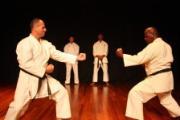
Think more flexibly about building bridges between the martial and performing arts, performance and practice, the seen and the unseen, Rhodes Drama lecturer, Ms Athina Valha implored her audience during an intriguing interdisciplinary presentation.
“Comprising of both theoretical and practical components, the ‘Beyond Fighting’ talk opens a window for observation and discussion with regards to arts of self-defence, as well as aspects of live performance, and the role of the body in conflict resolution,” said Ms Valha, who is also a performance artist and choreographer.
The lecture entitled “Beyond Fighting, conflict and violence in karate and aikido”, the third in a series of crossover ‘experiments’ took place at the Box Theatre, Rhodes University. It explored what happens when martial arts are placed within an entirely fresh context.
First to present was Rhodes Fine Art senior lecturer Maureen de Jager, who discussed the philosophy and history of karate while the practical demonstration was led by sensei Gary Grapentin and three local kareketa from East Cape Shotokan-Ryu.
The three kareketa’s expertly demonstrated the various repetitive drills and forms (kata) which are modelled on hypothetical combat scenarios: the movements are intended as blocks or strikes against an imaginary attacker. The speed and efficiency of their severely elegant movements often generated gasps of amazement from the audience.
In an entertaining presentation accompanied by slides and interspersed with references to the film Karate Kid (1984), Ms de Jager said “there’s more to karate than violence” and the age-old fight between good and evil, as depicted in the film.
Karate’s aim is “to kill with one blow”, according to an old samurai maxim. “Therefore,” Ms de Jager said, “if violence is unavoidable, one needs to respond quickly and efficiently with deadly intent.”
But it is also about exercising self-control and avoiding violence to begin with, which goes hand in hand with conquering the emotional overload of the “small violences” that disrupt one’s daily momentum.
Dr Denzil Beukes of the Pharmacy faculty then introduced his group of fellow aikidoka (some of which had travelled from Port Elizabeth to take part) dressed in black, elegantly pleated pants called hakama.
Modified from ancient samurai combat techniques, where a sword was used, aikido employs the use of “empty-handed combat” characterised by circular, flowing movements. The name ‘aikido’ can be roughly translated as the way (‘do’) of harmonious (‘ai’) energy (‘ki’).
Morihei Ueshiba (1883-1969), its founder, sought to bring peace to the world through aikido practice. In essence the ultimate aim of aikido is to defend oneself effectively while, at the same time, causing the least amount of harm to an opponent.
Dr Beukes admits that this requires life-long dedicated study to keep these qualities in mind, both while practicing aikido and in one’s daily life. “The secret of aikido is to become one with the universe and to live every day with integrity, as if it were your last,” he said.
He then continued to demonstrate a number of basic aikido techniques both with empty hand and wooden sword and staff. He emphasised that there is no real blocking or clashing in aikido but rather the aikidoka blends with and redirects the incoming attack.
The aim is to develop powerful technique, as effectively and effortlessly as possible. “Your movement adapts to what your partner does, you can feel where the tension is or how he/she is breathing, through the body and therefore sensing what’s happening in the mind. It’s a wordless communication and it works both ways.”
Photo and story by Anna-Karien Otto
